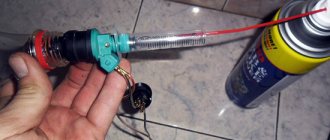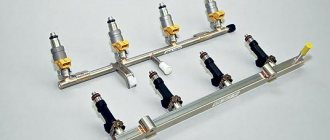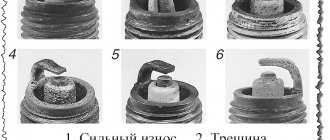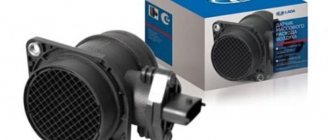The use of fuels and lubricants (in particular, gasoline) of not the best quality eventually ends in frequent breakdowns of the power unit. And any experienced car enthusiast knows very well that such fuel has a low octane number. This, in turn, leads to detonation of the working mixture in the combustion chamber. As a result, the service life of the engine is noticeably reduced, and repairs will have to be carried out much earlier. Moreover, everything can end very badly - with the death of the engine.
The solution suggests itself - fill the tank only with fuel that meets the needs of the power plant. It’s not for nothing that the manufacturer gives such valuable recommendations in the car’s instruction manual! Such a product is easy to find at gas stations in any city (especially large ones) or its environs.
But due to duty or for some other reasons (travel or car rides), a situation may certainly arise when fuel with the required characteristics cannot be found and you have to fill the tank with what is available. For this, it will be useful to know how to increase the octane number of gasoline. This information will be very useful for those drivers who often go on long trips.
But first, it’s worth considering the very definition of octane number and understanding what exactly is meant by this. And then we’ll look at several methods to increase it.
What's the point
First, let’s figure out what kind of indicator this is and why it should be improved.
So, the octane number characterizes the detonation properties of gasoline, that is, its ability to ignite at the right time and with the required quality.
This is the main indicator that receives special attention. For example, if the octane rating of gasoline is AI-95, then this indicates its detonation by 95% (like isooctane) and 5% (like heptane).
At the very first moment after oil refining, gasoline has a minimum octane number of 70. Later, using various methods and additives, this figure can be raised to the desired level.
The octane number is determined on a special stand (often it looks like a special motor for testing). The test is performed under various loads - small and medium.
But recently, special devices have begun to appear that simplify testing.
The parameters of the fuel used for the experiment are compared with standard compositions of isooctane and heptane. After this, gasoline is assigned its own “number”.
By the way, each organic compound has its own level of detonation resistance.
For example, methane has an octane rating of 107.5; propane – 105.7; benzene – 113; butane – 93.6; straight distilled gasoline - about 58, catalytic cracking - about 80-85 and catalytic reforming - 83-97.
Rating of the best additives
We have prepared a review, compiling the top 3 best additives for gasoline fuel. From the assortment of auto stores, only the highest quality and most effective ones were selected.
Liqui Moly Octane Plus (octane plus) - opens the rating with an octane corrector from a well-known German company. Recommended for use when detecting the fact of refueling with fuel that does not meet the octane number requirements. The tube has a volume of 150 ml, which is enough to fill 50-60 liters of gasoline. The manufacturer claims the possibility of increasing the octane number by 2-5.5 points (for AI92 and AI95, respectively). It is safe for health and does not damage engine structural elements. Cost 300-400 rubles.
TOTEK UMT is a domestic development created to increase the octane number and improve the performance characteristics of the fuel. It has a combined effect, which is to reduce fuel consumption by 5%, promote the formation of a protective film on fuel dosing elements and reduce the emission of harmful components into the atmosphere. A 0.5 liter package is enough for 250-270 liters of gasoline. The cost for one container unit is 600-700 rubles.
LAVR Oktane Plus - also belongs to the category of octane correctors. The manufacturer recommends its use if a high load is planned on the power unit. The positive aspects of use are an increase in octane number, protection of internal combustion engine elements, and reduction in consumption. Packaging: 310 ml bottle, which is enough for 100-120 liters of gasoline. Cost – 200 rubles.
Proper use of additives can significantly improve the performance characteristics of a vehicle and increase the service life of some engine parts. At the same time, use without measure can cause irreparable damage to the power unit.
Why change the octane setting?
With a low octane number, gasoline may ignite much earlier than necessary. In this case, the engine power decreases, and the detonation process, well known to many car enthusiasts, appears.
In addition, the use of low-octane gasoline leads to engine detonation, reducing the service life of a whole group of its main elements - seats, valves, spark plugs, and so on. If you abuse low-quality fuel, the engine will have to be overhauled much earlier than scheduled.
So in order to improve the quality of gasoline and significantly improve its performance, it is still necessary to increase the octane number.
How it's done? What are the features of each method? This is exactly what we will talk about in more detail.
What does octane number mean?
The octane number of gasoline is a measure of knock resistance, or rather an indicator of various types of fuel and their ignition during operation of the internal combustion engine. At low octane levels, the use of such fuel is fraught with negative consequences for the engine due to fuel detonation. The most common: premature wear of valves and seats, as well as burnt residue on the walls and surfaces. Therefore, the octane number must be suitable for a particular engine, and we will look at how to increase the octane number in this article.
Basic methods
Today there are several main ways to increase octane.
Catalytic cracking.
A process that can only be implemented in an oil refinery environment. This method involves heating oil on a catalyst to temperatures slightly above 500 degrees Celsius.
During heating, the molar mass in Alkanes decreases, which allows the output of two elements - aromatic carbons and Alkenes.
As a result, gasoline with an octane number of 91-92. The disadvantage of such fuel is the high concentration of aromatic carbohydrates. Consequently, when storing fuel for a long time, the octane number may decrease.
Catalytic reforming.
Here, the fuel obtained after direct distillation is heated to 500-520 degrees Celsius. At the same time, the catalyst (rhenium, aluminum oxide with platinum and other metals) is under pressure of about 35 atmospheres. At the final stage, 95-grade gasoline is obtained. Efficiency is about 75%.
As in the first case, this type of work is performed only under special conditions at the factory.
Methyl tert-butyl ether.
This is one of the most popular additives for increasing the octane number of fuel. Its characteristics are colorlessness, easy flammability, low toxicity, strong odor and high octane level.
It is enough to add about 15% of this ether (of the total volume of fuel) to gasoline to increase the octane number by 8-12 points.
Most often, this method is used to increase octane. But it has a drawback - gasoline obtained in this way evaporates much faster in sunny weather due to its increased volatility.
Alcohol additives (based on ethyl or methyl alcohol).
Also used to improve fuel quality. For example, by adding 1/10 of ethyl alcohol to AI-92 gasoline, you can make it 95. At the same time, the toxicity of exhaust emissions from the car is significantly reduced.
But this method has a number of disadvantages.
Thus, the ability of alcohol to absorb moisture is manifested, which requires the car enthusiast to take additional measures to “dry” the gasoline.
In addition, there is a high risk of blockages in the fuel system.
By the way, if no measures are taken, water appears in the fuel, which means increased consumption, incomplete combustion of the fuel mixture, a high risk of gasoline freezing in the system and other problems. Therefore, you will have to remove water from gasoline.
Tetraethyl lead.
One of the highest quality additives, which has been actively used since 1921.
1/20 of this substance is enough to raise the octane level by 15-18 positions.
Tetraethyl lead is used in combination with special “carrier substances”, which remove the lead oxide formed during combustion of the additive.
Today this method has been banned due to dangerous lead fumes and their negative effects on the human body. The vapors of the substance are very poisonous.
In addition, such fuel cannot be used in cars with catalytic converters (the equipment breaks down after just a few hours of operation).
Additives for increasing the octane number of gasoline
To increase the octane number, aromatic hydrocarbons and branched paraffinic hydrocarbons (alkanes) are added using USB-type units. It is with the use of these components that the octane number increases. But as you noticed, the substances used are called aromatic (aromatic hydrocarbons), that is, in layman’s terms, high-octane gasoline smells stronger than low-octane gasoline. There are also certain disadvantages to this, since high-octane gasoline is more volatile due to the inclusion of aromatic components. Which, when stored for a long time in an open container or with a certain connection between the container and the external environment, leads to a decrease in the octane number of gasoline. Therefore, we can say that high octane gasoline must be “fresh”.
Previously, in the USSR, tetraethyl lead, a toxic mixture containing lead, was used to increase the octane number. Unfortunately, tetraethyl lead is not only toxic in itself, but also quickly damages catalytic converters and lambda probes, which have become used in the design of modern cars, as a result of which this additive had to be abandoned. Manganese-based additives were also used, but these are now also prohibited for environmental reasons. In addition, an additive called ferrocene is sometimes used to increase the octane number. This additive (ferrocene) contains iron and creates a difficult-to-remove conductive deposit on the spark plugs (a red tint), which impairs the performance characteristics (you can see about them in the “Spark Plugs” section) and accordingly reduces the service life of the spark plugs.
Gasolines also contain other additives and impurities. Additives in gasoline perform various tasks. They reduce the amount of harmful impurities in gasoline - sulfur, water, clean engine parts or the fuel system, increase the octane number of gasoline (this was mentioned above). A relatively harmless anti-knock additive for the engine is methyl tert-butyl ether. Currently, it is most widely used in Ukraine, Russia and Europe.
It is quite possible to obtain gasoline with an octane number of more than 110 (these are aviation fuels, but again with additives of the same lead, which, again, is unacceptable for modern car engine management systems). In addition, there is a well-known scheme with mixing gas condensate, because the octane number of natural gas is usually above 100.
Cleansing
Such additives are designed to prevent the formation of deposits and carbon deposits on the injector and other parts of the fuel system. They should be used regularly (every 10 thousand km).
If deposits have already formed, then the use of a detergent composition can lead to their detachment and entry into the fuel. This causes damage to the injectors.
Dehumidifiers
At low air temperatures, water may condense on the walls of the gas tank.
To prevent this, drying additives consisting of alcohol and absorbent substances are used.
Such formulations are ineffective and can only remove small amounts of liquid. They do not solve the problem of low-quality gasoline diluted with water.
Catalysts
This type of additive can increase the octane number of fuel. An artificial increase in this indicator is advisable only if it is not possible to refuel the car with high-quality fuel.
Universal
Universal compositions, according to the manufacturer, perform all 3 tasks described above. But laboratory tests show that the amount of active ingredients in them is small. As a result, such substances have almost no effect.
Effect of additives
Of course, high-octane fuel is a big plus for the engine. The latter works more stable, power increases, fuel consumption decreases, and so on.
That is why the obsolete and inefficient types of fuel AI-76 and AI-80 are gradually coming out of use. But there are certain risks here too.
If you fill your car with gasoline with a “makeshift” increased octane number, you may encounter a number of problems, starting with the usual replacement of spark plugs and ending with a major engine overhaul.
Other additives.
Offers on the market.
Maximum octane number of gasoline
The development of internal combustion engine technology is moving along the path of increasing power and increasing efficiency. As these parameters increase, the requirements for the fuel used increase.
The use of additives based on organometallics (tetraethyl lead, ferrocene, etc.) makes it possible to obtain gasoline with a knock resistance of 130-140 units. However, in most developed countries, such additives to automobile fuel are prohibited for environmental reasons. Unleaded (tetraethyl lead-free) gasoline can have an octane number of up to 109 units.
Most modern cars are designed to use 95 or 98 octane gasoline.
Racing cars use fuel with a higher octane number - up to 102 (according to FIA technical regulations). The highest octane number of gasoline is typical for some types of aviation fuel - up to 115.
Comparison of the properties of various antiknock agents
Threshold concentration values for some additives and their other operational features:
- Oxygenates (lower alcohols and ethers). The threshold concentration of the additive is 15%. Features: relatively low heat of combustion and high aggressiveness towards rubber products. The maximum increase in fuel octane index is 4–6 units. Parameters of several esters used as additives. Methyl tert-butyl (MTBE) – average octane number 114, boiling point 55 ◦C; ethyl tert-butyl (ETBE) – average octane number 110, boiling point 70 ◦C; methyl tert-amyl (MTAE) – average octane index 104.5, boiling point 87 ◦C; diisopropyl (DIPE) – average octane index 104.5, boiling point 69 ◦C.
- Lead based additives. The threshold metal saturation of gasoline is 0.17 g/l. Features: high level of toxicity and carbon formation in the combustion chamber. The maximum increase in the gasoline detonation resistance index is 8 units. Such additives are not used nowadays.
- Containing manganese. The threshold concentration of metal in fuel is 50 mg/l. Features: increased wear of parts of the cylinder-piston group, significant carbon formation on the spark plugs and in the combustion chamber. The maximum increase in the detonation resistance index is 5–6 units.
- Iron-containing. Threshold concentration – 38 mg/l. Leads to increased wear of engine pistons and cylinders due to noticeable ash deposits during combustion. The maximum increase in the number of detonation resistance of gasoline is 3–4 units.
- Aromatic amines, for example, aminobenzene (aniline), which is prohibited for use in its pure form due to its extreme toxicity. Of the substances in this group, only monomethylaniline (N-methylaniline) is approved for use. Threshold concentration 1–1.3%. The peculiarity of the additive based on this substance is its high octane number. During the experiment, a value of 280 units was obtained. However, there are also significant drawbacks, which include significant resin deposits on engine parts and fuel system. There is also increased wear of parts of the cylinder-piston group. The maximum increase in the number of knock resistance of gasoline achieved by using such an additive is 6 units.
How to lower the octane number of gasoline
Time is moving forward by leaps and bounds - you will no longer find 76 and 80 gasoline at gas stations. But ten-year-old walk-behind tractors or go-karts, which are still working without problems, require exactly this kind of fuel. Buying new ones is not an option. Using, for example, 92 gasoline will lead to uneven engine operation. Therefore, it is necessary to reduce the octane number of the mixture.
How to do it? Let’s use “folk” methods - leave the open canister in the open air, every day the octane level decreases by 0.5. It is too long. Then we use kerosene as an additive - a method previously used for vintage cars. The only negative is that it is quite difficult to choose the proportions.
If you use this method, then before use you need to measure the octane number.
Myths about octane number
At the beginning of the article, it was noted that only a few car owners clearly understand what octane number is. The result of this was the emergence of a large number of myths. And if some of them are relatively harmless, then believing in others can result in serious damage to the car.
Myth 1. The combustion temperature of high-octane gasoline is higher, so the engine develops more power. The octane number has nothing to do with the combustion temperature and the amount of heat released. All brands of gasoline have similar calorific values, so you should not expect to increase engine power by using high-octane fuel.
Myth 2: Octane rating can be measured with a portable device. All kinds of “octane meters” give a fairly approximate value of the octane number, so you should not rely on them entirely. The exact value of detonation resistance can only be obtained through bench tests.
Reviews from car owners
Positive reviews from car owners primarily concern cleaning mixtures. Many believe that thanks to their regular use they were able to extend the life of their car. Most people call catalytic additives a waste of money and recommend buying high-quality gasoline instead.
Which type of additives - universal or specialized - is more effective (in your opinion)?
- Engine additives
- Shampoo for contactless car wash rating
- Which compressor to choose for a car
- Anti-corrosion agents for cars
- Diesel or gasoline, which is better for an SUV?
Measuring the octane number of gasoline
The octane number of gasoline is measured in various ways:
- Research octane number (RON) and motor octane number (MON). The difference between them is represented as the sensitivity of the fuel mixture.
- "Actual octane number." It is determined under real operating conditions on a special stand with the engine running.
- "Road" octane number. The result is as close as possible to the real mixture, because determined directly in the vehicle.
It is quite simple to measure the octane number in everyday life - there are many devices - octane meters - available for sale. Their operating principle is based on measuring the dielectric constant of gasoline. This value is proportional to the octane number. To determine the exact value, there are calibration tables - comparing fuel with an already known number and the use of n-heptane.
The principle of comparing control samples with other gasolines is inherent in the UIT-65 and UIT-85 motor units. The octane number of diesel fuel can be determined similarly. This method became possible because in the production of gasoline, the direct distillation method is no longer used, but campauding (mixing) is used.
The disadvantages of this method include the inability to analyze the octane number of unidentified gasoline, i.e. brands of gasoline not included in certain databases.
It is also difficult to create a unified model, and therefore it is difficult to analyze gasolines that are produced in different ways (cracking/reforming/others) and mixtures of different types.
The following restrictions apply to the use of this model: prior calibration against a standard is required and the temperature must be within the specific range specified in the instrument specification.
Use gasoline with parameters recommended by the manufacturer. Remember, failure to comply with these rules can lead to serious problems with the engine, including engine breakdown, the need for major repairs or replacement of valves and pistons. To measure the octane number of fuel, use the special instruments named in the article and similar to them.
Reducing the risk of detonation using improvised means
- Adding 10% ethyl or any other alcohol to gasoline can increase its octane number by 3 units. The disadvantage of this method is the formation of vapor locks in the gas lines, which impede the operation of the fuel system. This is due to the rather low boiling point of alcohols, which is especially noticeable in hot weather. Another disadvantage of this technique is that alcohols are very hygroscopic and well absorb moisture from the air, which in severe frost will freeze, forming ice plugs in the fuel line. Of course, access to gasoline in this case will be blocked.
- You can increase the knock resistance of gasoline fuel by adding acetone to it. According to data published online by amateur experimenters, adding 1 liter of acetone to 20 liters of gasoline increases its octane number by 6 units. However, they did not carry out measurements, relying only on detonation. A car whose engine was designed for AI-98 was filled with AI-92, and acetone was added to the fuel until detonation disappeared.
- The use of additives to increase the knock resistance of gasoline, sold in auto chemical stores. It must be borne in mind that if you believe the reviews, additives containing iron and amine compounds are the most effective. Please note that additives containing iron can, especially if used systematically, cause spark plug failure.
Recommended octane number for the car
The question of which fuel is best to use for a car can be given a definite answer - the one prescribed for a specific type of engine. The use of low-octane gasoline, as mentioned earlier, will lead to detonation.
Many modern cars are equipped with anti-knock systems, so they can consume fuel with an octane rating lower than the recommended one. But at the same time, fuel consumption increases and engine power decreases, which makes trying to save in this way pointless.
However, using fuel with an octane number exceeding the recommended one will not be beneficial. At best, this will result in increased costs due to the higher cost of high-octane fuel. At worst, incomplete combustion of gasoline may occur.
Is it worth filling
In order not to ruin your car’s engine, it is important not to thoughtlessly purchase additives at a car dealership and pour them into the unit uncontrollably, but to initially arm yourself with the recommendations of specialists and weigh all the arguments for and against the use of additives.
It is important to take into account that cunning enterprising businessmen, seeking to sell low-quality fuel at a higher price, even before selling it, add octane-increasing additives to the composition, misleading motorists. As a result, after the next portion of the additive is introduced directly by the car owner, a glut of additives occurs, which negatively affects the condition of the engine. For this reason, it is not recommended to use auto chemicals unless necessary. It will be much more efficient to get service at gas stations that you trust.
Methyl tert-butyl ether
Today this is the most popular method. Methyl tert-butyl ether (MTBE), having a huge indicator of detonation resistance (more than 100 units), provides a positive effect on engine operation: enriched with oxygen, it ensures complete combustion and reduces exhaust containing the elements CO and CH. The disadvantages include the fact that the increased content of MTBE (more than 20%) causes a decrease in service life and an increase in emissions of nitrogen oxides (NOx) into the atmosphere. However, this method has its negative consequences - red soot on the spark plugs or combustion chambers. At the same time, as a symptom of a decrease in the resource and power of the car, the spark plugs constantly triple or even fail.
Detonation resistance
Octane number, or octane index, is a parameter that characterizes the ability of gasoline not to ignite under compression.
The indicator is equal to the volumetric percentage of isooctane in a mixture with n-heptane, at which the detonation resistance of this liquid and the gasoline under study is the same.
Isooctane is extremely reluctant to ignite even at a very high compression ratio, so its octane number is taken to be 100. H-heptane, on the contrary, easily self-ignites even at a low compression ratio, therefore the value of its anti-knock parameter was set to zero.
The first to study the ability of gasoline to detonate in the 21st century was the Englishman Harry Ricardo. He suggested using a scale of gasoline resistance to detonation. For a long time, the main anti-knock additive for gasoline was tetraethyl lead. Adding just 0.01% of this substance to gasoline increases its knock resistance index by 3 units. But since it is very poisonous, its use as a gasoline additive is now prohibited.
Instead, in order to increase anti-knock properties, safer additives are now used, for example, methyl tert-butyl ether, which is considered today the most promising means for this purpose. Its mixture with tert-butyl alcohol is also used. The disadvantages of these additives are their high aggressiveness towards rubber products and low (about 50 ◦C) boiling point.
The latter is the reason for the evaporation of these additives from the fuel in the heat.
Regardless of the chemical nature of the antiknock agent, the concentration of the additive in gasoline is limited for objective reasons, which leads to a low increase in octane number. In addition, the increase in the gasoline knock resistance index depends nonlinearly on the additive concentration. For each antiknock agent there is a threshold concentration, after which the detonation resistance indicator does not increase.
How to use additives?
To get the maximum benefit from using fuel additives, they must be used correctly. Read the instructions for use in advance, and only then proceed to use. First of all, you need to prepare the engine, it should be washed. This is done in the following cases:
- Before a complete oil change.
- If you switch to another engine oil brand.
- If you need to restore your car after using low-quality petroleum products.
- After completion of repair work.
To flush the engine, you must use special flushing oils. You can buy them in special stores. Keep in mind that flushing oil is a transition component. It is used when it is necessary to switch to another engine oil. If you want to use fuel additives, use them only if you fill the tank full.
As fuel passes through the combustion chamber, the engine gets rid of soot and deposits. The rings of the piston system are gradually cleaned. To get maximum benefit, it is necessary to add additional additives to the engine lubrication system. After filling the fuel additive, you must drive especially carefully for the first 300 kilometers, not to overload the system with additional load.











